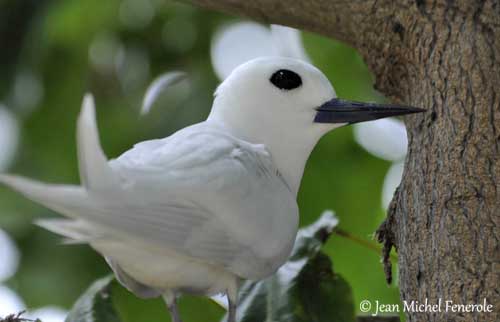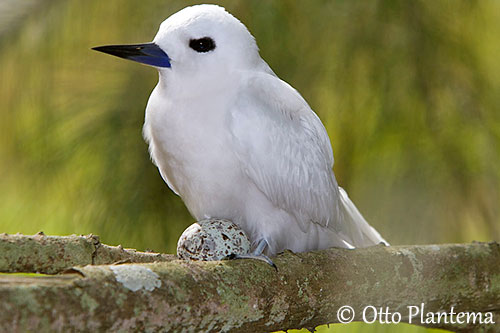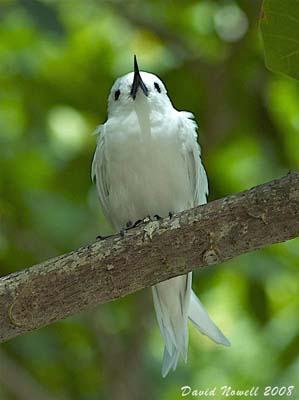
(Common) White Tern
Gygis alba
Charadriiforme Order - Laridae Family
BIOMETRICS:
Length: 28-33 cm; Wingspan: 66-78 cm; Weight: 100-140 g
LONGEVITY: 17 years
DESCRIPTION:
White Tern has entire white plumage. Wings appear almost translucent in flight; tail shows a shallow fork.
Thick pointed bill is slightly up-curved. It is black, with blue at the base. Black eyes are rounded by black eye ring, making large eyes. Legs and webbed feet are greyish, and webs are yellow to white.
Both sexes are similar.
Chick is covered with grey to white down. It has grey down on crown, nape and back. When chick closes its eyes, they look as if they are open, due to the spots around the eyes. This is probably for protection. Chick has sharp clawed feet, allowing hanging on the nest branch in string winds.

HABITAT:
White Tern is a pelagic bird living in oceanic areas, and relatively close to breeding islands. They breed in wooded islands. They are migratory or dispersive.
RANGE:
White Tern is found in tropical and subtropical oceans and islands. They breed in tropical and subtropical Pacific, Indian and South Atlantic Oceans.
BEHAVIOUR:
White Tern is often seen singly or in small groups. It is a diurnal bird, but more active at dusk and dawn.
To feed, it dips its bill to catch a prey at the surface or just under it. Dive is often preceded by hovering, that is a strong expensive activity, and White Tern may sustain its flight with help of the wind. It may carry several small fishes in its bill, and return to the young with preys held crosswise. They are probably skilled to catch other fishes with yet full bill. They feed on small fishes and aquatic preys of 2 to 8 cm long.
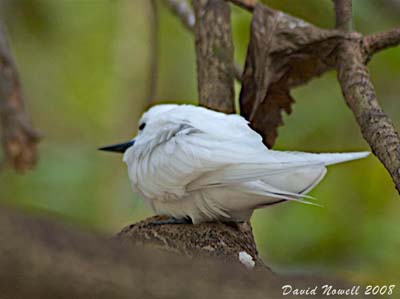
White Tern nest in loose group or singly. Pair remains together for several seasons and returns to the same nest site every year.
At the beginning of breeding season, pairs perform aerial displays flying together. They probably use courtship feeding, with male giving a prey to the female, and mutual preening perched on a branch.
When disturbed by predators, the White Tern hovers, flutters and produces buzzing sounds.
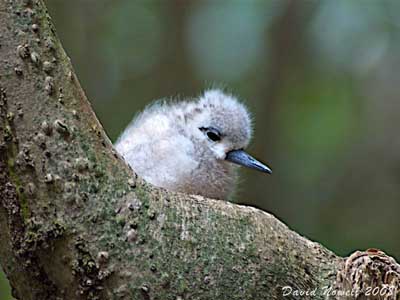
Fr: Gygis blanche
All: Feenseeschwalbe
Esp: Charrán Blanco
Ital: Sterna Bianca
Nd: Witte Stern
Sd: Fetärna
Photographers:
Jean Michel Fenerole
Photos d’Oiseaux du monde
David Nowell
GALLERY
Otto Plantema
Trips around the world
Text by Nicole Bouglouan
Sources:
HANDBOOK OF THE BIRDS OF THE WORLD Volume 3 by Josep del Hoyo-Andrew Elliott-Jordi Sargatal - Lynx Edicions, 1996, 821 pages - ISBN : 8487334202
L’ENCYCLOPEDIE MONDIALE DES OISEAUX - Dr Christopher M. Perrins - BORDAS - ISBN: 2040185607
Wikipedia (Wikipedia, The Free Encyclopedia)
All About Birds (Cornell Lab of Ornithology)
CREAGUS@Monterey Bay (Don Roberson)
REPRODUCTION:
White Tern doesn’t build nest. Sometimes, it scratches the bark of o short high branch in tree, to create a shallow small depression, using feet and bill. Egg may be laid on roof or other surface, always on bare surfaces, up to 20 metres above the ground.
Female lays only one speckled egg in this precarious place, making it vulnerable to high winds. Incubation lasts about 36 days, shared by both parents, each parent sits during 48 to 72 hours on the nest.
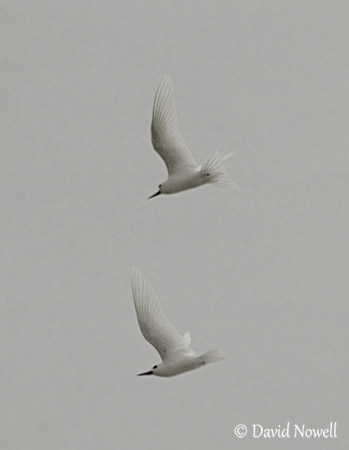
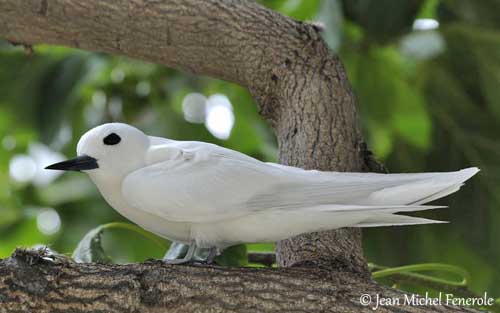
White Tern has four subspecies:
Gygis alba alba
Gygis alba candida
Gygis alba microrhyncha
Gygis alba leucopes
These races slightly differ in flight feathers and legs’ colours, and in bill shape.
VOICE: SOUNDS BY XENO-CANTO
White Tern’s call is a repeated guttural “heech-heech”. They are usually silent at the nest site.
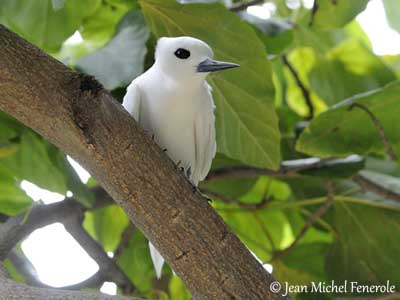
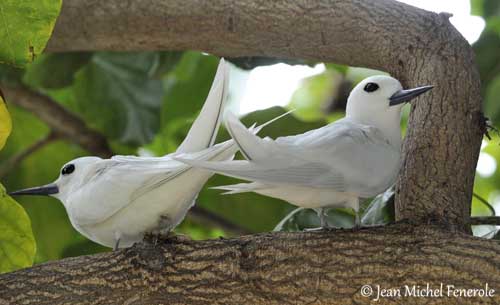
The white chick hatches on this branch, and has to grab it very strongly with its sharp claws. Both parents feed it every 3 hours, with whole small fish or squid. Chick is brooded on the branch.
Young fledge at about 48 days of age, moving into surrounding area of the nest site. It returns to its nest branch only to be fed. Both parents feed it during 2 months more.
Young reaches its sexual maturity at about 3 to 5 years. This species may produce two to three broods per year.
DIET:
White Tern feeds mainly on small fishes and squid, and also on some crustaceans.
PROTECTION / THREATS / STATUS:
White Tern population numbers vary, according to their range. Worldwide population is unknown, but may exceed 100,000 breeding pairs.
